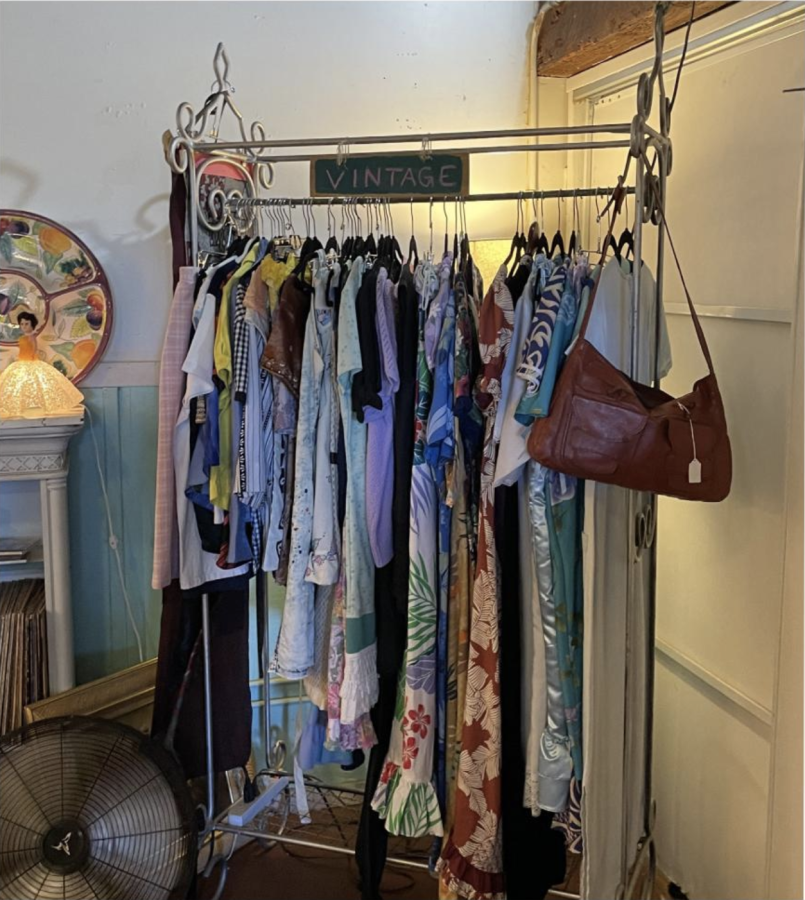Sustainability’s Chic Style Secrets
Green Gypsy Thrift Shop is a sustainable clothing thrifting option located in Honolulu, Hawaii
March 15, 2022
Count to 150 billion. I dare you. Start counting… on your marks… get set… go! You’re probably thinking: there’s no way I could count to 150 billion! Me neither, but while researching the negative impacts of the trend cycle I discovered that this massive number is produced per year in just clothing. Of the 7.753 billion individuals on the planet, with this amount of production, each person could have 14 new pieces of clothing each year. Some of you might be wondering: What’s so bad about that? I could go for some new clothes. But did you know that discarded clothes in landfills take over 200 years to decompose? Not to mention the toxicity of dyes and chemicals that find their way into our groundwater and soil. The rise of ‘fast fashion’ has caused an environmental crisis that’s effects will soon be irreversible to the planet. As an avid sustainability advocate, I would strongly encourage you to start shopping green.
When using the phrase ‘green’ I don’t mean drenching your closet in different hues of sages and emeralds. Don’t get me wrong… I’m a sucker for a good green outfit, but the meaning of a ‘green wardrobe’ has changed dramatically in the past few years. So… What is a green wardrobe? A green closet is a sustainable, environmentally conscious wardrobe that breaks damaging fashion cycles. While it sounds daunting, having ethically aware apparel is much more simple than it sounds.
With the concept of a green closet comes the idea of a ‘capsule wardrobe.’ Originally created by shop-owner Susie Faux, the phrase is defined as ‘a limited number of essential or staple items that you can wear for multiple seasons.’ A capsule wardrobe can be vastly different depending on the person. Whether a flannel and jeans, or a leather jacket and shorts carry you through years of outfits–the idea remains the same: reducing consumption of unethically sourced unnecessary additions to your closet. Shopping green doesn’t just mean where the clothes come from, it also correlates to how much consumers buy from retail. Even if everyone shopped from sustainable brands for the rest of their lives, the impact would still be huge if buying trends continue at the same rate they are right now. Massive clothing ‘hauls’ and other social media trends encourage shoppers to continue buying new clothes at a ridiculously alarming rate. A good way to pause before overconsuming is to ask not only “Would I wear this in five years?” but also “Would I have worn this five years ago?”
So… How does one shop in an environmentally friendly fashion? Sustainable brands like Patagonia, Reformation, and Kotn provide style and ethics to the regular consumer, but as companies lean more toward sustainability, often times they lose their marketing of affordability. Understandably, many people veer towards more affordable options at the expense of their environmental footprint. Supporting brands like Shein, Forever 21, and RipCurl keeps the vicious eco-toxic cycle alive and kicking. To those with concerns about the price-point of sustainably-sourced brands thrifting is an incredible alternative.
If you’re willing to invest a little bit more time and effort into your shopping experience, going to a local thrift store is a great way to decrease your carbon footprint through your closet. Thrifting can be a little daunting at first, and many times the process is stigmatized by the idea of ‘wearing someone else’s clothes.’ To that I ask: is it better to wear vintage pre-loved clothing… or clothing made in sweatshops with a style shelf-life of less than a year. At the end of the day, your decisions are up to you but with hope for the fate of our globe, I encourage you to find sustainability chic.


